tow CHEVROLET TRACKER 1998 1.G Owner's Manual
[x] Cancel search | Manufacturer: CHEVROLET, Model Year: 1998, Model line: TRACKER, Model: CHEVROLET TRACKER 1998 1.GPages: 386, PDF Size: 21.17 MB
Page 91 of 386
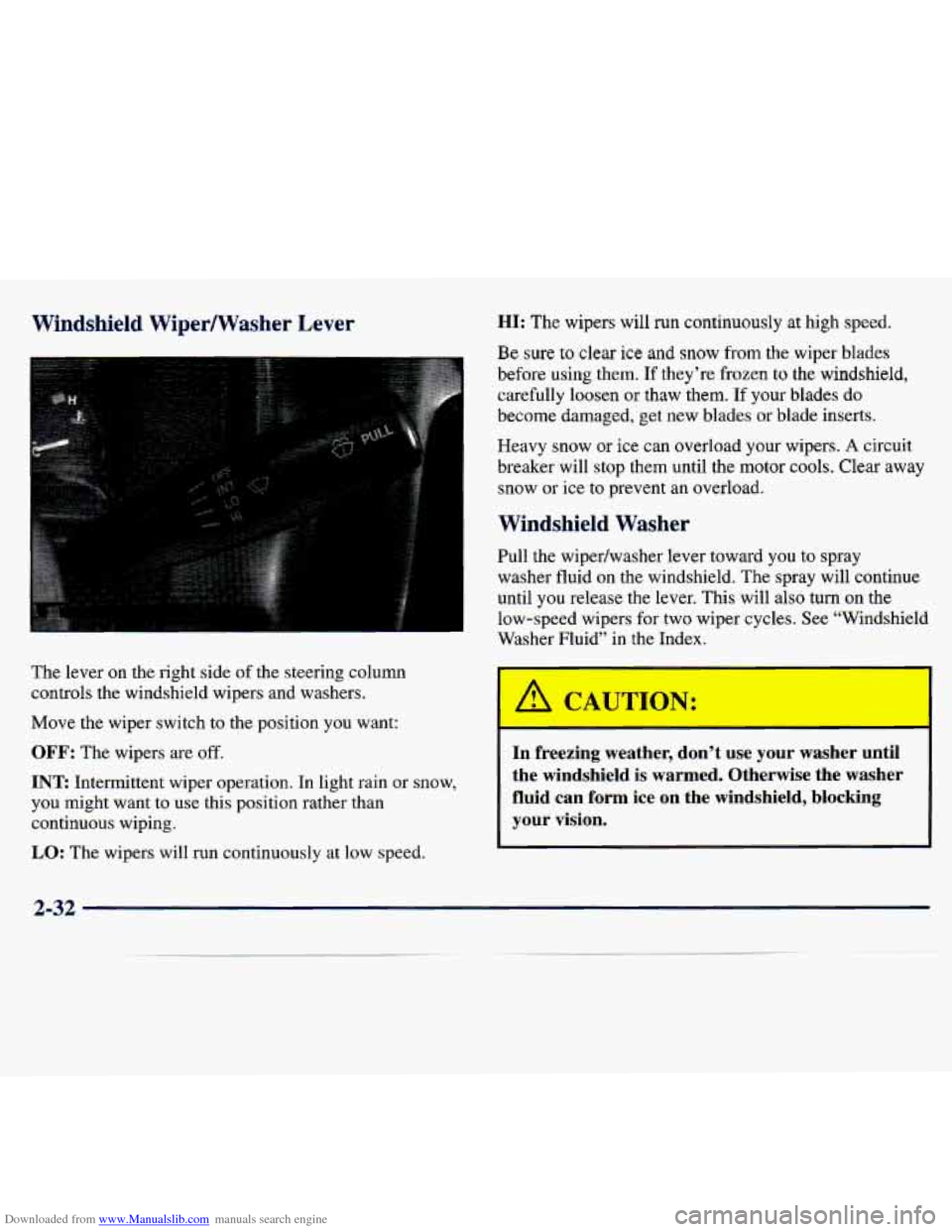
Downloaded from www.Manualslib.com manuals search engine Windshield WiperNasher Lever
The lever on the right side of the steering column
controls the windshield wipers and washers.
Move the wiper switch to the position
you want:
OFF: The wipers are off.
INT Intermittent wiper operation. In light rain or snow,
you might want to use this position rather than
continuous wiping.
LO: The wipers will run continuously at low speed.
HI: The wipers will run continuously at high speed.
Be sure to clear ice and snow from the wiper blades
before using them.
If they’re frozen to the windshield,
carefully loosen
or thaw them. If your blades do
become damaged, get new blades or blade inserts.
Heavy snow or ice can overload your wipers.
A circuit
breaker will stop them until the motor cools. Clear away
snow or ice to prevent an overload.
Windshield Washer
Pull the wipedwasher lever toward you to spray
washer fluid on the windshield. The spray will continue
until you release
the lever. This will also turn on the
low-speed wipers
for two wiper cycles. See “Windshield
Washer Fluid” in the Index.
A CAUTIC -V:
I-=--
In freezing weather, don’t use your washer until
the windshield is warmed. Otherwise the washer
fluid can form ice
on the windshield, blocking
your vision.
M
2-32
Page 98 of 386
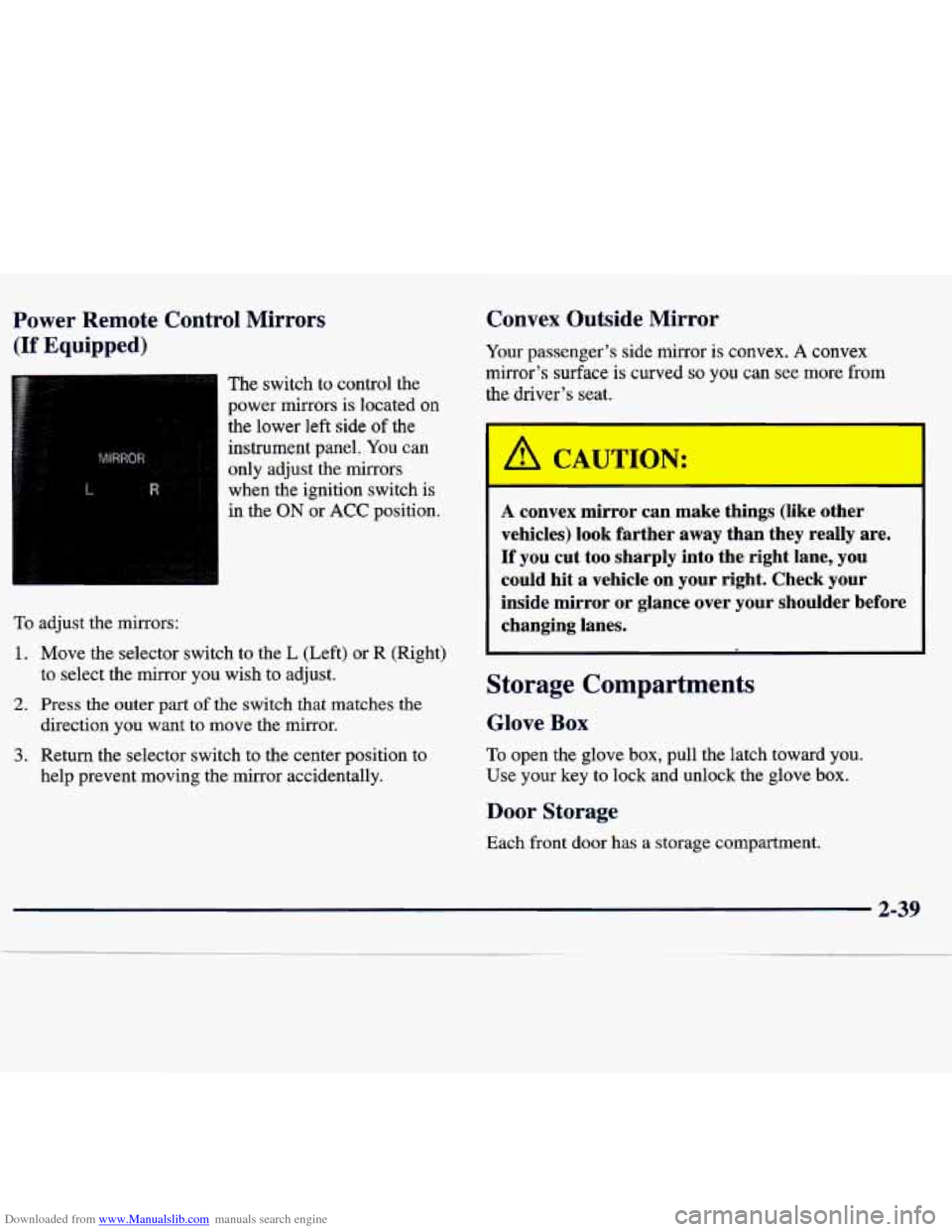
Downloaded from www.Manualslib.com manuals search engine Power Remote Control Mirrors
(If Equipped)
The switch to control the
power mirrors
is located on
the lower left side
of the
instrument panel.
You can
only adjust the mirrors
when the ignition switch is
in the
ON or ACC position.
To adjust the mirrors:
1. Move the selector switch to the L (Left) or R (Right)
to select the
mirror you wish to adjust.
2. Press the outer part of the switch that matches the
3. Return the selector switch to the center position to direction you want to move
the mirror.
help prevent moving the mirror accidentally.
Convex Outside Mirror
Your passenger’s side mirror is convex. A convex
mirror’s surface is curved
so you can Bee more from
the driver’s seat.
/A CA,TION:
A convex mirror can make things (like other
vehicles) look farther away than they really are.
If you cut too sharply into the right lane, you
could hit a vehicle on your right. Check your
inside mirror or glance over your shoulder before changing lanes.
Storage Compartments
Glove Box
To open the glove box, pull the latch toward you.
Use your key to lock and unlock the glove box.
Door Storage
Each front door has a storage compartment.
2-39
Page 119 of 386
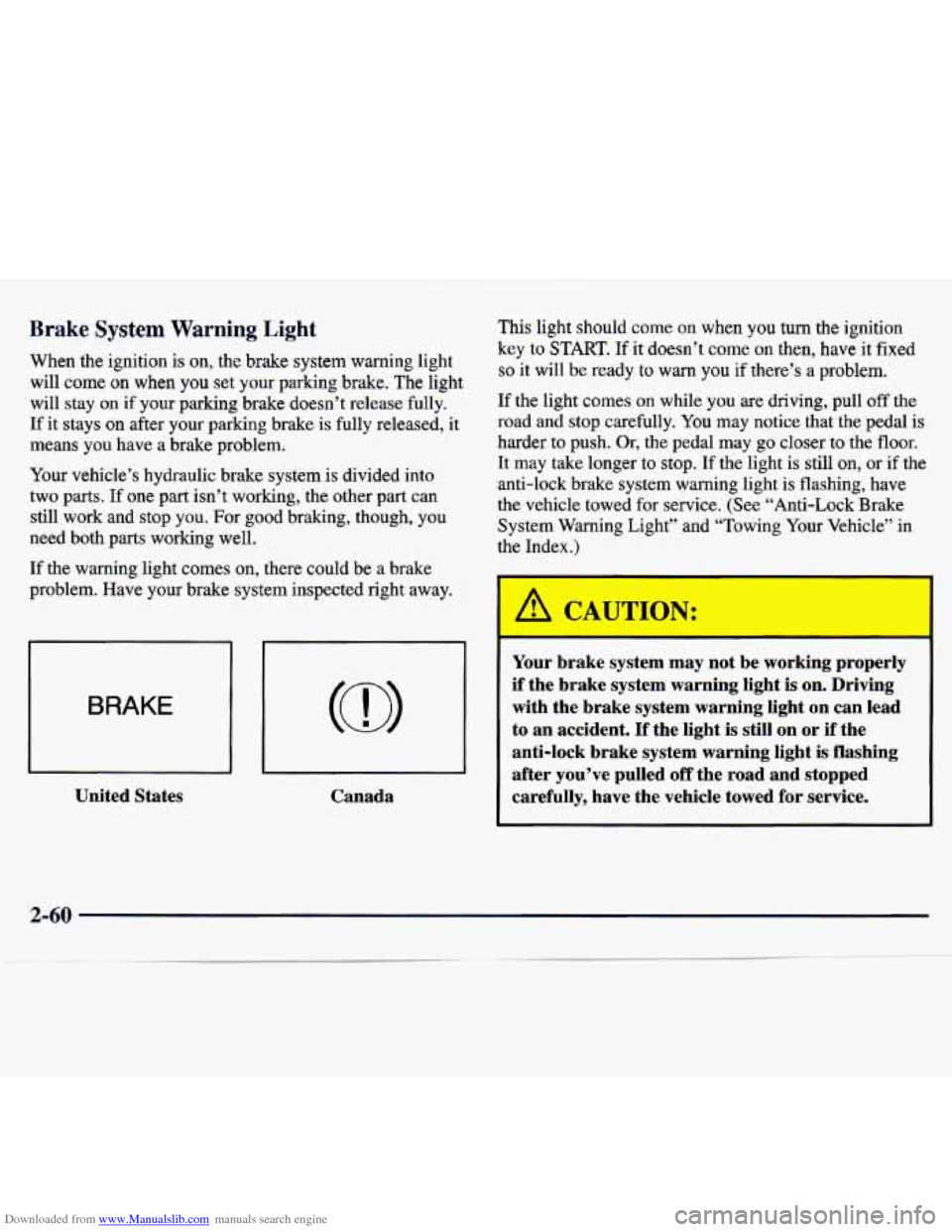
Downloaded from www.Manualslib.com manuals search engine Brake System Warning Light
When the ignition is on, the brake system warning light will come
on when you set your parking brake. The light
will stay on if your parking brake doesn’t release fully.
If it stays on after your parking brake is fully released, it
means
you have a brake problem.
Your vehicle’s hydraulic brake system is divided into
two
parts. If one part isn’t working, the other part can
still work and stop you. For good braking, though, you
need both parts working well.
If the warning light comes on, there could be a brake
problem. Have your brake system inspected right away.
BRAKE
United States Canada
This light should come on when you turn the ignition
key to START. If it doesn’t come on then, have it fixed
so it will be ready to warn you if there’s a problem.
If the light comes
on while you are driving, pull off the
road and stop carefully. You may notice that the pedal is
harder to push. Or,
the pedal may go closer to the floor.
It may take longer to stop.
If the light is still on, or if the
anti-lock brake system warning light is flashing, have
the vehicle towed for service. (See “Anti-Lock Brake
System Warning Light” and “Towing Your Vehicle” in
the Index.)
I k!, CAUTION:
Your brake system may not be working properly
if the brake system warning light is on. Driving
with the brake system warning light on can lead
to an accident. If the light is still on or if the
anti-lock brake system warning light is flashing
after you’ve pulled
off the road and stopped
carefully, have the vehicle towed for service.
2-60
Page 120 of 386
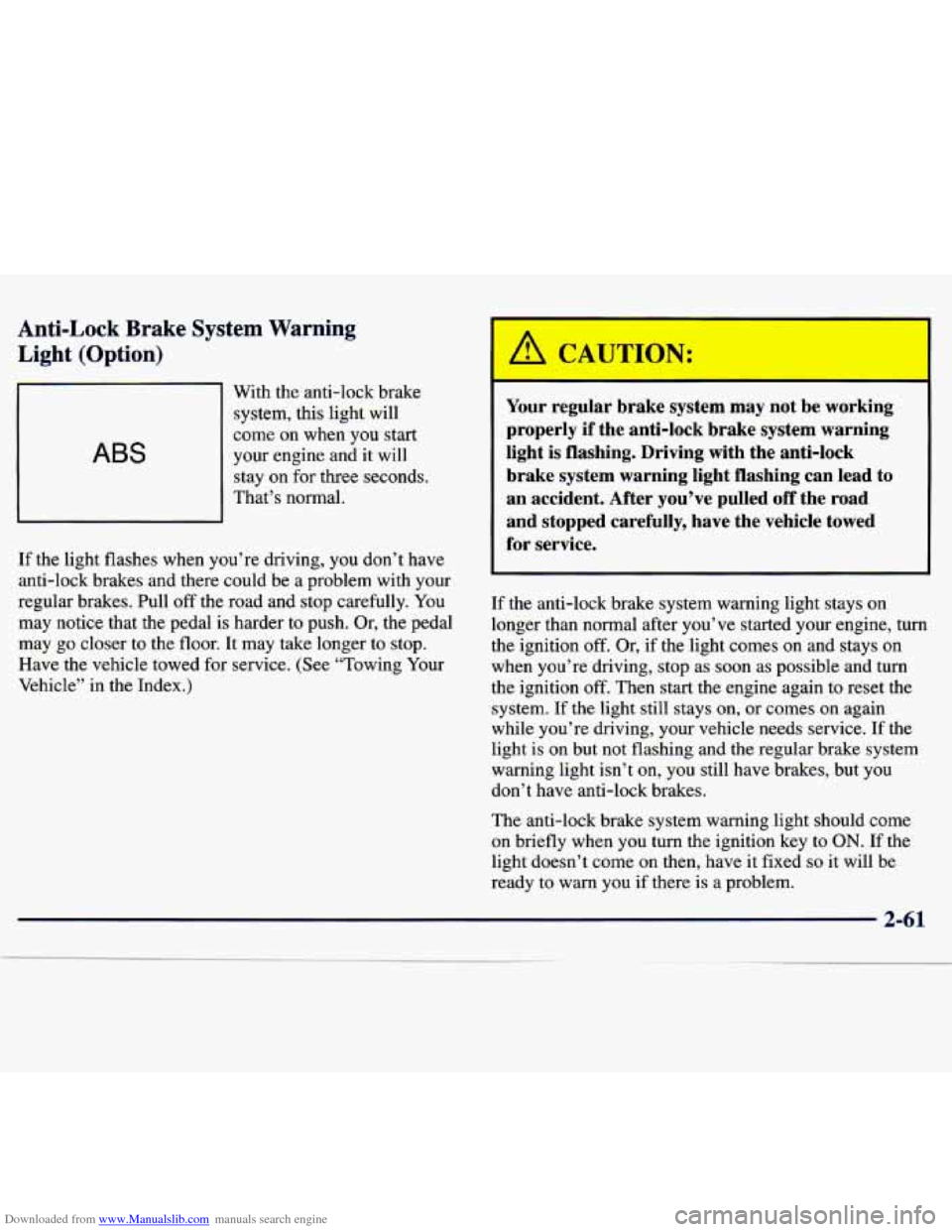
Downloaded from www.Manualslib.com manuals search engine Anti-Lock Brake System Warning
Light (Option)
ABS
With the anti-lock brake
system, this light will
come on when you start
your engine and it will
stay on for three seconds.
That’s normal.
If the light flashes when you’re driving, you don’t have
anti-lock brakes and there could be a problem with your
regular brakes. Pull
off the road and stop carefully. You
may notice that the pedal is harder to push. Or, the pedal
may
go closer to the floor. It may take longer to stop.
Have the vehicle towed for service. (See “Towing Your
Vehicle’’ in the Index.)
I
I h, CAUTION:
Your regular brake system may not be working
properly if the anti-lock brake system warning
light is flashing. Driving with the anti-lock
brake system warning light flashing can lead to an accident. After you’ve pulled off the road
and stopped carefully, have the vehicle towed
for service.
If the anti-lock brake system warning light stays on longer than normal after you’ve started your engine, turn
the ignition off. Or, if the light comes
on and stays on
when you’re driving, stop
as soon as possible and turn
the ignition off. Then start the engine again to reset the
system.
If the light still stays on, or comes on again
while you’re driving, your vehicle needs service. If the
light is on but not flashing and the regular brake system
warning light isn’t on, you still have brakes, but
you
don’t have anti-lock brakes.
The anti-lock brake system warning light should come
on briefly when you turn the ignition key to
ON. If the
light doesn’t come on
then, have it fixed so it will be
ready to warn you
if there is a problem.
Page 123 of 386

Downloaded from www.Manualslib.com manuals search engine If the Light Is Flashing
The following may prevent more serious damage to
your vehicle:
Reducing vehicle speed.
0 Avoiding hard accelerations.
Avoiding steep uphill grades.
If the Light Is On Steady
If you are towing a trailer, reduce the amount of
cargo being hauled as soon as it is possible.
If the light stops flashing and remains on steady, see
“If
the Light Is On Steady’’ following.
If the light continues to flash, when it is safe to do so,
stop the vehicle. Find a safe place to park your vehicle.
Turn the key off, wait at least 10 seconds and restart the
engine. If the light remains on steady, see “If the Light
Is On Steady’’ following. If the light is still flashing,
follow the previous steps, and drive the vehicle to your
dealer or qualified service center for service.
You may be able to correct the emission system
malfunction by considering the following:
Did you recently put fuel into your vehicle?
If so, reinstall the fuel cap, making sure to fully install
the cap. The diagnostic system can determine if the fuel
cap has been left
off or improperly installed. A loose or
missing fuel cap will allow fuel to evaporate into the
atmosphere.
A few driving trips with the cap properly
installed should
turn the light off.
Did you just drive through a deep puddle of water?
If so, your electrical system may be wet. The condition
will usually be corrected when the electrical system
dries out. A few driving trips should
turn the light off.
Are you low on fuel?
As your engine starts to run out of fuel, your engine may
not run as efficiently as designed since small amounts of
air are sucked into the fuel line causing a misfire. The
system can detect
this. Adding fuel should correct this
condition. Make sure to install the fuel cap properly. It
will take a few driving trips to turn the light
off.
j
2-64
I
~ i
I
Page 129 of 386
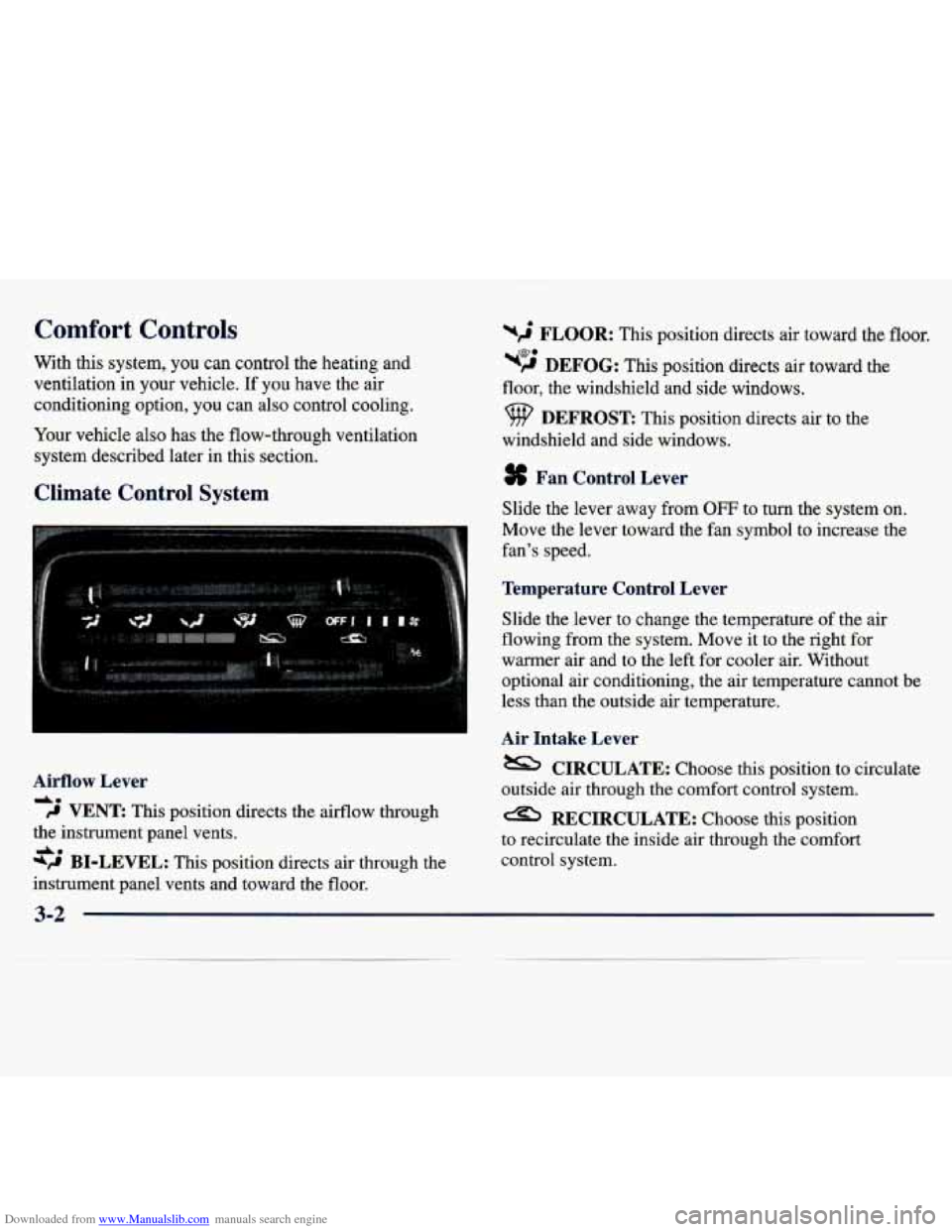
Downloaded from www.Manualslib.com manuals search engine Comfort Controls
With this system, you can control the heating and
ventilation in your vehicle.
If you have the air
conditioning option, you can also control cooling.
Your vehicle also has the flow-through ventilation
system described later in this section.
Climate Control System
Airflow Lever
dm
9 VENT This position directs the airflow through
the instrument panel vents.
*P BI-LEVEL: This position directs air through the
instrument panel vents and toward the floor.
A.
wJ FLOOR: This position directs air toward the floor.
w? DEFOG: This position directs air toward the
floor, the windshield and side windows.
DEFROST This position directs air to the
windshield and side windows.
Fan Control Lever
Slide the lever away from OFF to turn the system on.
Move the lever toward the fan symbol to increase the
fan’s speed.
Temperature Control Lever
Slide the lever to change the temperature of the air
flowing from the system. Move it to the right for
warmer air and to the left for cooler air. Without
optional air conditioning, the air temperature cannot be
less than the outside air temperature.
Air Intake Lever
CIRCULATE:
Choose this position to circulate
outside air through the comfort control system.
a RECIRCULATE: Choose this position
to recirculate the inside air through the
comfort
control system.
3-2
Page 130 of 386
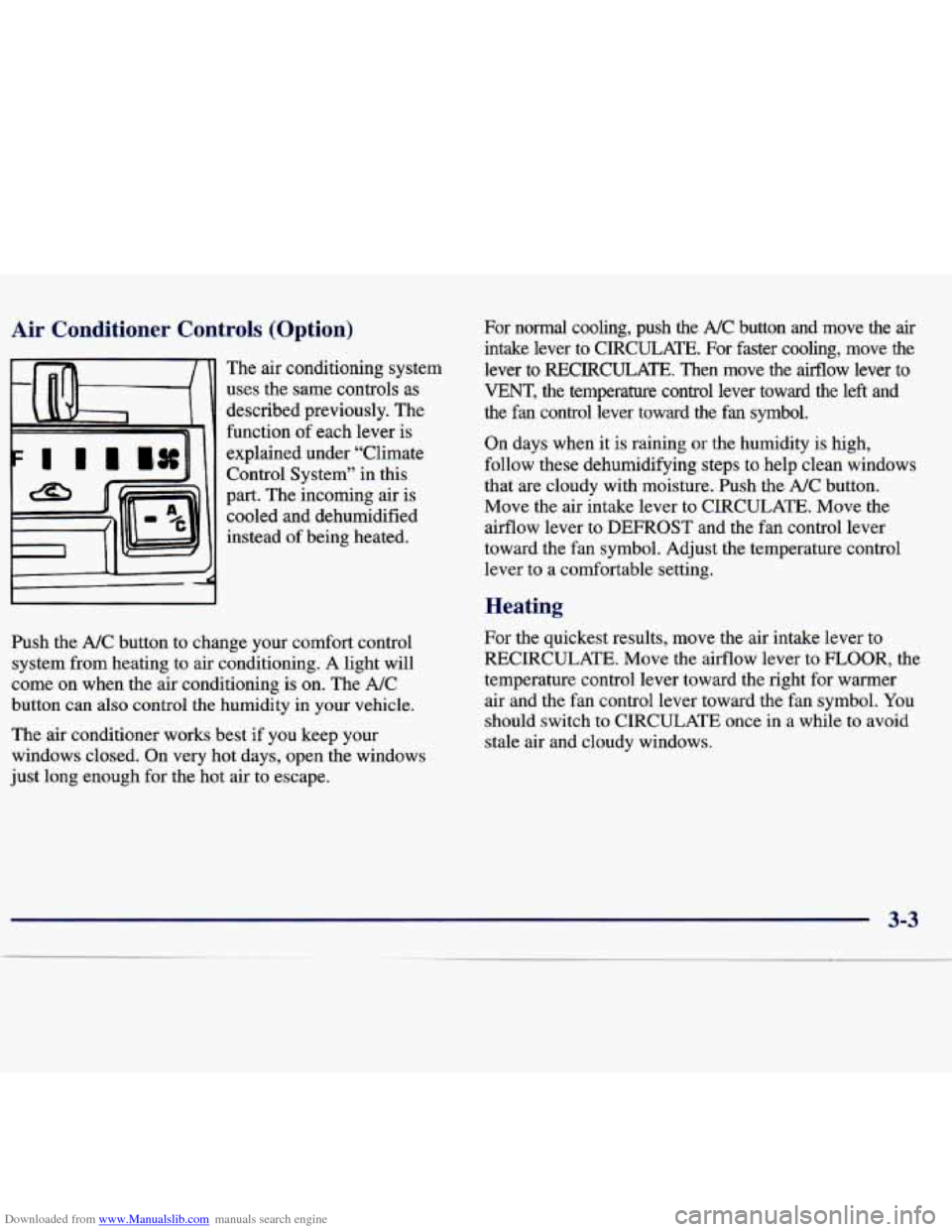
Downloaded from www.Manualslib.com manuals search engine Air Conditioner Controls (Option)
c
The air conditioning system
uses the same controls
as
described previously. The
function
of each lever is
explained under “Climate
Control System” in this
part. The incoming air is
cooled and dehumidified
instead of being heated.
Push the
A/C button to change your comfort control
system from heating to air conditioning. A light will
come on when the air conditioning is on. The
A/C
button can also control the humidity in your vehicle.
The air conditioner works best if you keep your
windows closed. On very hot days, open the windows
just long enough for the hot air to escape. For normal cooling, push the
A/C button and move the air
intake lever to CIRCULATE. For faster cooling, move the
lever to
RECIRCULAR. Then move the airflow lever to
VENT, the temperature control lever toward the left and
the fan control lever toward the fan symbol.
On days when it is raining or the humidity is high,
follow these dehumidifying steps to help clean windows
that are cloudy with moisture. Push the
A/C button.
Move the air intake lever to CIRCULATE. Move the
airflow lever to DEFROST and the fan control lever
toward the fan symbol. Adjust the temperature control
lever to a comfortable setting.
Heating
For the quickest results, move the air intake lever to
RECIRCULATE. Move the airflow lever to FLOOR, the
temperature control lever toward the right for warmer
air and the fan control lever toward the fan symbol. You
should switch to CIRCULATE once in a while to avoid
stale air and cloudy windows.
3-3
-
Page 131 of 386
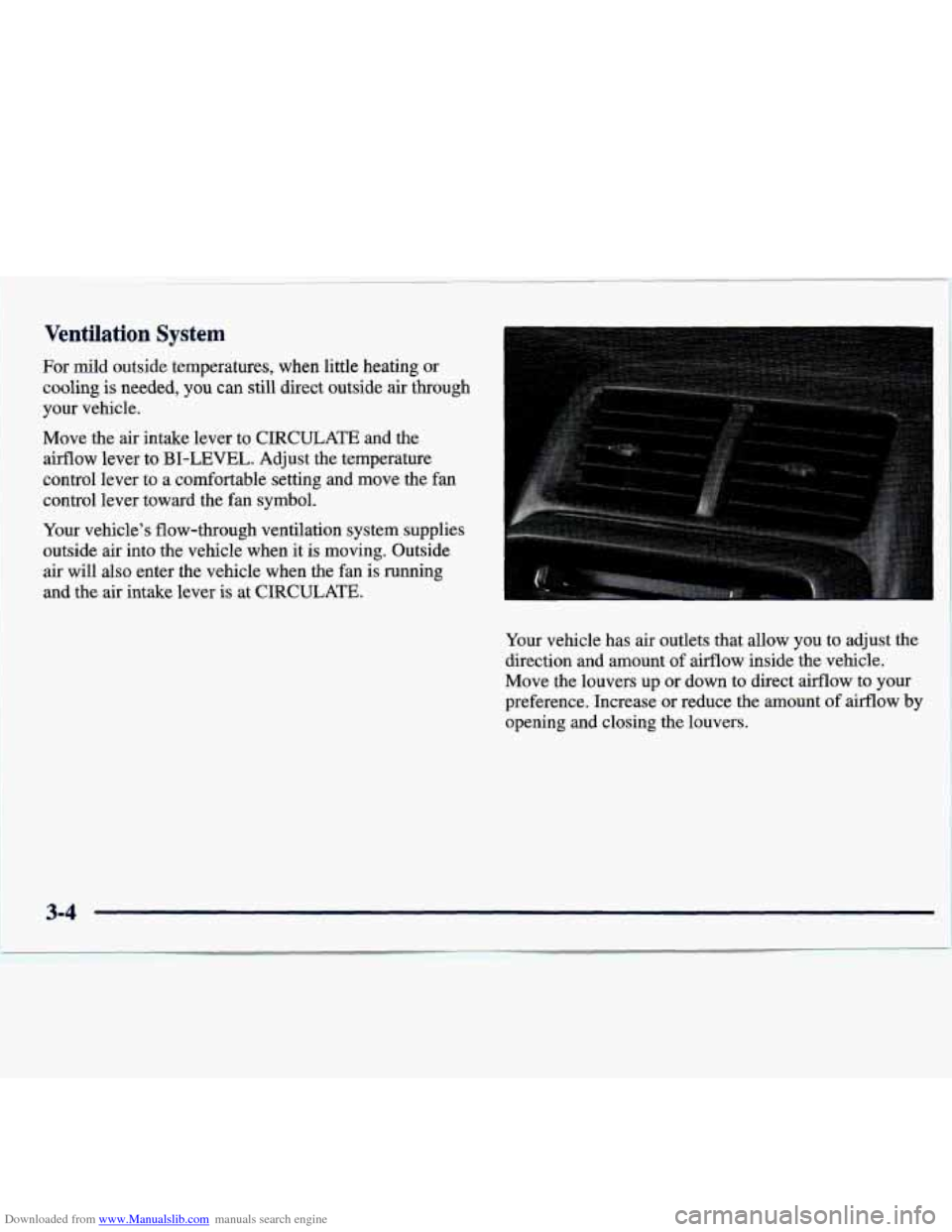
Downloaded from www.Manualslib.com manuals search engine Ventilation System
For mild outside temperatures, when little heating or
cooling
is needed, you can still direct outside air through
your vehicle.
Move the air intake lever to CIRCULATE and the aifflow lever to
BI-LEVEL. Adjust the temperature
control lever
to a comfortable setting and move the fan
control lever toward the fan symbol.
Your vehicle’s flow-through ventilation system supplies outside air into the vehicle when it is moving. Outside
air will also enter the vehicle when the fan is running
and the air intake lever is at
CIRCULATE.
Your vehicle has air outlets that allow you to adjust the
direction and mount of airflow inside the vehicle.
Move the louvers up or down to direct airflow to your preference. Increase
or reduce the amount of airflow by
opening and closing the louvers.
Page 132 of 386

Downloaded from www.Manualslib.com manuals search engine Ventilation Tips Rear Window Defogger (If Equipped)
Keep the hood and front air inlet free of ice, snow or any
other obstruction (such
as leaves). The heater and
defroster will work far better, reducing the chance of
fogging the inside
of your windows.
When
you enter a vehicle in cold weather, move the fan
control lever toward the fan symbol for a few moments
before driving
off. This helps clear the intake ducts of
snow and moisture, and reduces the chance
of fogging
the inside
of your windows. The
rear window defogger
uses
a warming grid to
remove fog from the
rear window.
Keep the air path under the front seats clear of objects.
This helps air to circulate throughout your vehicle.
Defogging and Defrosting
Slide the air intake lever to CIRCULATE and the
airflow lever to DEFROST to direct air to the
windshield vents. Then slide the temperature control
lever toward
the right and the fan lever toward the fan
symbol. When the windshield is clear, turn down the
fan speed. Press the switch to turn on the defogger. An indicator
light will come on below the switch to remind you that
the defogger is on. Press the switch again to turn the
defogger
off. The rear window defogger will also turn
off if you turn the ignition switch to ACC or LOCK, but
will turn back on when the ignition is turned back on.
Do not attach anything like a temporary vehicle license
or a decal across the defogger grid on the rear window.
3-5
Page 146 of 386
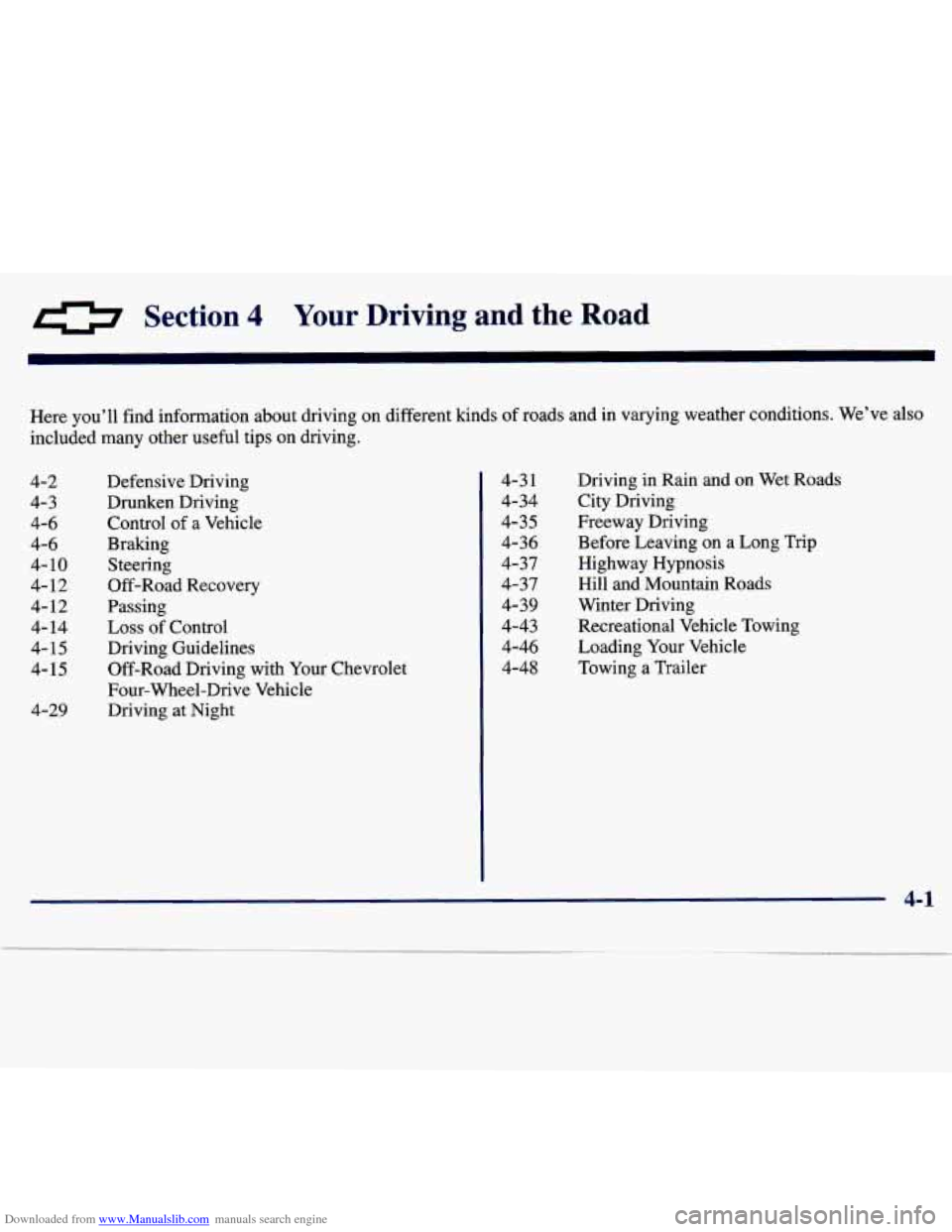
Downloaded from www.Manualslib.com manuals search engine 0 Section 4 Your Driving and the Road
Here you’ll find information about driving on different lunds of roads and in varying weather conditions. We’ve also
included many other useful tips on driving.
4-2
4-3 4-6
4-6
4- 10
4-12
4- 12 4- 14
4-
15
4-15
4-29 Defensive Driving
Drunken Driving
Control of a Vehicle
Braking
Steering
Off-Road Recovery
Passing
Loss of Control
Driving Guidelines
Off-Road Driving with Your Chevrolet
Four-Wheel-Drive Vehicle
Driving
at Night 4-3 1
4-34
4-35
4-36
4-37
4-37
4-39
4-43 4-46
4-48 Driving in Rain and on
Wet Roads
City Driving
Freeway Driving
Before Leaving on a Long Trip Highway Hypnosis
Hill and Mountain Roads
Winter Driving
Recreational Vehicle Towing Loading Your Vehicle
Towing a Trailer
4-1